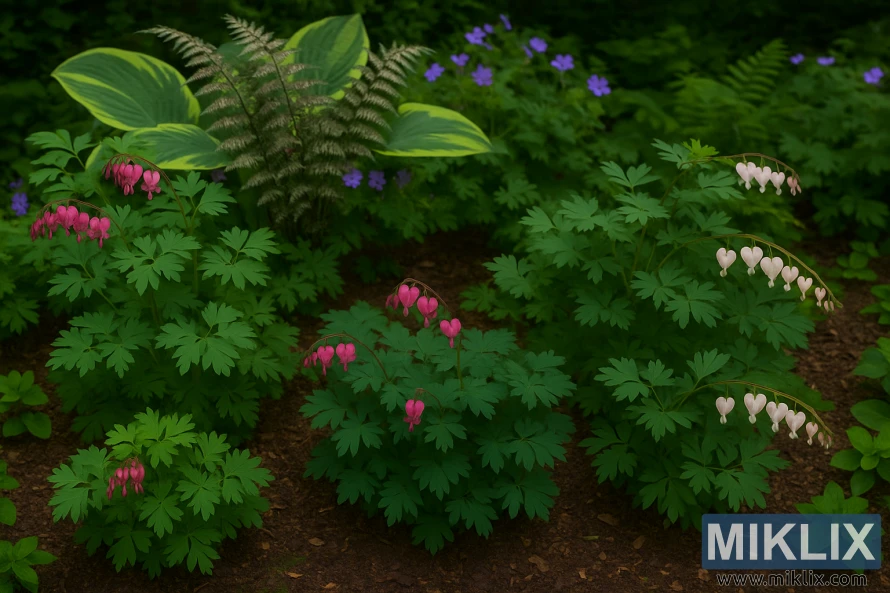Image: Shade Garden with Bleeding Heart Varieties and Companion Plants
Published: October 29, 2025 at 10:11:28 PM UTC
A high-resolution landscape photo of a serene shade garden featuring multiple Bleeding Heart varieties alongside hostas, ferns, and other companion plants, captured in gentle, diffused natural light.
This high-resolution landscape photograph captures the tranquil beauty of a well-designed shade garden in full spring bloom. The scene is composed with balance and natural elegance, highlighting several varieties of Bleeding Heart (Dicentra) interwoven with companion plants that thrive in partial shade. At the forefront of the composition, three distinct Dicentra cultivars bloom in graceful harmony: deep rose-pink ‘Luxuriant’ to the left, vibrant magenta ‘King of Hearts’ in the center, and the delicate blush-white ‘Aurora’ to the right. Each variety displays its distinctive charm — their pendulous, heart-shaped blossoms hanging elegantly from arching stems above a base of finely textured, fern-like foliage.
Behind these focal plants, an array of complementary greenery enriches the scene. Large, variegated Hosta leaves rise confidently in the background, their bold chartreuse centers edged in deep green. Beside them, the silvery fronds of a Japanese Painted Fern add soft contrast, their feathery texture mirroring the intricate foliage of the Dicentra. Sprinkled throughout the bed are subtle accents of color — violet-blue Geranium blossoms and tender shoots of Astilbe and young Heuchera leaves — contributing to a layered palette of pink, green, silver, and purple tones.
The soil beneath the plants is carpeted in rich, organic mulch, grounding the composition and enhancing the natural woodland feel of the setting. The light filtering through the canopy above is soft and diffused, dappling the leaves and petals with subtle highlights. This gentle illumination evokes the serene atmosphere of a cool, shaded garden on a calm morning, where every detail — from the curvature of a flower stem to the sheen of a fern frond — feels alive and deliberate.
The photograph’s framing is artful yet unpretentious, allowing the viewer’s eye to wander naturally from foreground to background, guided by the flow of shapes and colors. The trio of Bleeding Heart plants anchors the image with rhythmic repetition, while the companion plants lend structure and diversity. The interplay between the plants’ forms — the broad, architectural Hosta leaves juxtaposed against the airy, delicate blossoms — demonstrates expert garden design grounded in texture and contrast.
Emotionally, the image conveys a sense of calm, intimacy, and refined natural beauty. It embodies the timeless appeal of shade gardens, where subtle hues and textures take precedence over bright color. The Bleeding Heart flowers, with their characteristic heart-shaped pendants, seem to float in the dim light, symbolizing grace, renewal, and quiet devotion. The surrounding foliage provides both a visual and metaphorical frame — a sanctuary of greenery that nurtures and accentuates the blossoms’ fleeting charm.
As a botanical portrait, this photograph captures the essence of harmonious garden composition — an interplay of structure, softness, and color variation. Every plant, from the humble groundcover to the stately Hosta, contributes to an atmosphere of understated elegance and living artistry. The result is a portrait not only of plants, but of balance — a visual meditation on the relationship between form, texture, and tranquility in the cultivated natural world.
The image is related to: A Guide to the Most Beautiful Varieties of Bleeding Heart to Grow in Your Garden

